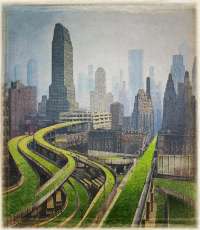Today our metropolitan networks require more and more physical space for their residual infrastructure and paradoxically seem to leave less and less legroom for urban appropriation by their occupants. Rather than being subjugated to it, the supremacy of the automobile and of its underlying apparatus now dictates the city’s internal development and subsequently can be held accountable for the scarcity of the resulting vital spaces at its core. In this sense, rather than inner parks or outer green belts, it is perhaps the channelling connective tissue of the autobahn itself which provides the best site for a manifesto. Oxygen (2001) is a consciously utopian installation which aims to uncover the significance of this lack of vital spaces within our contemporary way of life. Whereas the space for the automobile and the space for the tamed manifestation of nature in the form of vegetation / greenery could in principle be substituted, both constructs emanate from the same suburban ideology which ironically is what accounts for the lack and precisely what narrows our understanding of its implications. In other words, while the project in essence could be carried out, its conceptual potency rests in the very problematic implied in its realization. Peter Boyadjieff, May 2011
Today our metropolitan networks require more and more physical space for their residual infrastructure and paradoxically seem to leave less and less legroom for urban appropriation by their occupants. Rather than being subjugated to it, the supremacy of the automobile and of its underlying apparatus now dictates the city’s internal development and subsequently can be held accountable for the scarcity of the resulting vital spaces at its core. In this sense, rather than inner parks or outer green belts, it is perhaps the channelling connective tissue of the autobahn itself which provides the best site for a manifesto. Oxygen (2001) is a consciously utopian installation which aims to uncover the significance of this lack of vital spaces within our contemporary way of life. Whereas the space for the automobile and the space for the tamed manifestation of nature in the form of vegetation / greenery could in principle be substituted, both constructs emanate from the same suburban ideology which ironically is what accounts for the lack and precisely what narrows our understanding of its implications. In other words, while the project in essence could be carried out, its conceptual potency rests in the very problematic implied in its realization. Peter Boyadjieff, May 2011

